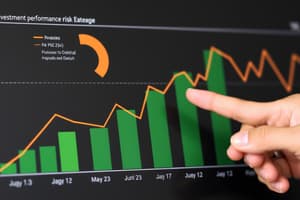Podcast
Questions and Answers
What is the primary purpose of diversification in an investment portfolio?
What is the primary purpose of diversification in an investment portfolio?
- To combine distinct investments to reduce individual security risk (correct)
- To focus on a single security for higher returns
- To guarantee a positive return on all investments
- To maximize returns regardless of risk
How does the relationship between risk and return affect investor decisions?
How does the relationship between risk and return affect investor decisions?
- All investors have the same understanding of risk
- To earn higher returns, investors must generally accept higher risk (correct)
- Investors prefer securities with low returns and high risk
- Investors always select low-risk investments for better outcomes
Why might an investor choose an active approach over a passive approach to managing a portfolio?
Why might an investor choose an active approach over a passive approach to managing a portfolio?
- There are specific market niches that can be better served by active management (correct)
- Passive management involves continuously trading securities
- Active management guarantees higher returns
- Investors prefer to completely avoid any form of risk
What constitutes a rational investor's choice when presented with two investments of equal risk?
What constitutes a rational investor's choice when presented with two investments of equal risk?
What are some perspectives on what constitutes risk in investments?
What are some perspectives on what constitutes risk in investments?
Which of the following best describes the role of an advisor or portfolio manager?
Which of the following best describes the role of an advisor or portfolio manager?
What aspect of a portfolio is primarily left due to the positive correlation among securities?
What aspect of a portfolio is primarily left due to the positive correlation among securities?
Which beta value indicates a security or portfolio that moves less than the market?
Which beta value indicates a security or portfolio that moves less than the market?
If an equity portfolio has a beta of 0.60, what is expected to happen when the market rises by 10%?
If an equity portfolio has a beta of 0.60, what is expected to happen when the market rises by 10%?
What is the relationship of a portfolio with a beta of 2.0 during a market drop of 5%?
What is the relationship of a portfolio with a beta of 2.0 during a market drop of 5%?
What does beta specifically measure regarding an equity portfolio?
What does beta specifically measure regarding an equity portfolio?
What is an implication of achieving maximum gain from diversification?
What is an implication of achieving maximum gain from diversification?
What is the primary purpose of diversifying a portfolio of securities?
What is the primary purpose of diversifying a portfolio of securities?
What is defined as cash flow derived from an investment?
What is defined as cash flow derived from an investment?
Which of the following statements about expected return is true?
Which of the following statements about expected return is true?
How is a capital gain defined?
How is a capital gain defined?
What does the term 'expected ending value' refer to in investment calculations?
What does the term 'expected ending value' refer to in investment calculations?
What does the formula for expected return primarily consider?
What does the formula for expected return primarily consider?
Which type of investment would best suit someone seeking income?
Which type of investment would best suit someone seeking income?
Which of these aspects does NOT contribute to the overall return of an investment?
Which of these aspects does NOT contribute to the overall return of an investment?
What is one challenge associated with determining a realistic expected rate of return?
What is one challenge associated with determining a realistic expected rate of return?
How do corporate bonds compare to Government of Canada bonds in terms of expected returns?
How do corporate bonds compare to Government of Canada bonds in terms of expected returns?
What does studying historical returns provide investors?
What does studying historical returns provide investors?
What characterizes the nominal rate of return?
What characterizes the nominal rate of return?
What can be inferred about the relationship between risk and expected return from the provided content?
What can be inferred about the relationship between risk and expected return from the provided content?
Which investment is likely to have the lowest expected return based on the risk-return relationship?
Which investment is likely to have the lowest expected return based on the risk-return relationship?
What is the primary concern of investors when examining the real rate of return?
What is the primary concern of investors when examining the real rate of return?
Which of the following statements about expected returns is true?
Which of the following statements about expected returns is true?
Which investment type is frequently analyzed for expected returns compared to T-bills based on risk?
Which investment type is frequently analyzed for expected returns compared to T-bills based on risk?
Why is it misleading to rely solely on historical performance for future investment predictions?
Why is it misleading to rely solely on historical performance for future investment predictions?
Flashcards are hidden until you start studying
Study Notes
Risk and Return
- Diversification is a strategy that combines different investments in a portfolio to reduce individual security risk.
- Investors and advisors use measures and methods to estimate risk and predict return.
- Portfolio construction aims to meet individual investors' needs in different market situations.
- Higher returns often come with higher risk, and investors must consider their risk profiles when making decisions.
- Investors have different views of risk, some perceive it as the potential loss of money, while others view it as the risk of losing purchasing power due to inflation.
Calculating Rate of Return
- The expected return of a single security is calculated by adding the expected cash flow and the expected capital gain (or subtracting the expected capital loss) and dividing the result by the beginning value.
- The formula for expected return is: Expected Cash Flow + Expected Capital Gain (or - Capital Loss) / Beginning Value.
- Expected cash flow refers to dividends, interest, or any other type of income derived from the investment.
- Expected capital gain/loss is calculated by subtracting the beginning value from the expected ending value.
- The beginning value represents the initial amount invested.
- The expected ending value is the anticipated value of the investment upon sale.
Historical Returns
- Investors can gain insights into the market and formulate investment strategies by analyzing historical data.
- Historical returns provide valuable information about long-term market performance.
- Although historical returns can be used to estimate future returns, they cannot accurately predict the future performance of the market.
Risk and Return Relationship
- Higher expected returns generally correspond to higher risk, whereas lower risk often translates to lower expected returns.
- The relationship between risk and return is illustrated by the risk and return graph, which shows various securities ranked by their expected return and risk level.
Nominal and Real Rates of Return
- Nominal rate of return represents the simple rate of return without adjusting for inflation.
- Real rate of return is adjusted for the impact of inflation to reflect the actual purchasing power of the investment.
- Investors are more interested in real rates of return than nominal rates, as they provide a clearer picture of the actual return after accounting for inflation.
Portfolio Diversification
- Diversification aims to reduce risk by spreading investments across multiple securities with different characteristics.
- The maximum diversification benefit is achieved when securities in the portfolio have a perfect negative correlation, meaning they move in opposite directions, offsetting each other's fluctuations.
- In reality, achieving perfect negative correlation is challenging, and most securities in a portfolio exhibit some degree of positive correlation.
- Systematic risk, which cannot be eliminated through diversification, represents the impact of market movements on individual securities.
Portfolio Beta
- Beta measures the volatility of a single equity or equity portfolio relative to the overall stock market.
- A beta of 1.0 indicates that a security or portfolio moves in line with the market, while a beta greater than 1.0 suggests greater volatility and a beta less than 1.0 indicates lower volatility.
- Beta values can help investors assess the risk associated with specific investments and determine how they might be affected by market fluctuations.
Industry Rotation
- Industry Rotation involves shifting investments between cyclical industries and defensive industries based on market conditions.
- Cyclical industries perform well during economic expansions but tend to decline during recessions.
- Defensive industries, such as utilities and consumer staples, are less sensitive to economic fluctuations and tend to perform better during recessions.
Fixed-Income Manager Styles
- Fixed-income managers invest in fixed-income securities, such as bonds, mortgage-backed securities, and preferred shares, based on factors like maturity period, credit quality, and their outlook on interest rates.
- Short-term managers invest in T-bills and short-term bonds with maturities of less than five years.
- Medium-term managers focus on investments with maturities ranging from five to 10 years.
Studying That Suits You
Use AI to generate personalized quizzes and flashcards to suit your learning preferences.




